If you’re like me and have a passion for gardening, you know that it takes time, patience, and knowledge to create the garden of your dreams. That’s why I’m excited to introduce you to “Master the Green Thumb: Your Guide to Studying Gardening.” This comprehensive guide covers everything you need to know to get started, including tips and techniques for plant care, garden design, and essential tools. Whether you’re a beginner or an experienced gardener, this guide has something for everyone.
Key Takeaways:
- Whether you’re a beginner or an experienced gardener, “Master the Green Thumb: Your Guide to Studying Gardening” has something for everyone.
- This comprehensive guide covers topics such as plant care, garden design, essential tools, watering techniques, pruning, pest management, and much more.
- The guide offers specific tips for keeping houseplants alive and emphasizes the importance of getting to know your plants’ needs and behavior.
- The North Dakota Extension Master Gardener Program is highlighted as an organization that provides horticulture training and encourages people of all ages to learn more about gardening.
Selecting the Right Plants for Beginners
As a beginner gardener, selecting the right plants is crucial for your success. With so many options available, it can be overwhelming to choose the right ones that suit your space, skill level, and plant care requirements. To start, consider plants like tomatoes, basil, and marigolds that are beginner-friendly and align with factors such as sunlight availability, water demands, and available space.
Healthy soil is key to the success of your plants. Make sure to test your soil and amend it accordingly to ensure nutrient-rich conditions. Additionally, equipping yourself with the right tools like a trowel, pruner, and watering can makes the gardening experience more efficient and enjoyable.
Effective planning is another aspect to consider. Take into account the size and shape of your garden plot, as well as factors such as sunlight and wind exposure. Precise watering is also important; water your plants thoroughly and monitor moisture levels regularly to avoid under or over-watering. Regular maintenance and addressing pest issues are also key to ensuring healthy plant growth.
It’s essential to get to know your plants and their specific needs. Provide them with adequate light and soil drainage, and consider factors like moisture and the seasons of bloom when selecting plants. For instance, if you’re looking for plants that flower in the summer, consider sunflowers and zinnias.
The North Dakota Extension Master Gardener Program encourages people of all ages to learn more about gardening in their region. They offer events and workshops to educate the public on planning gardens and suggest specific perennials, annuals, and plants that attract pollinators for different conditions and purposes.
In summary, selecting the right plants is vital to the success of your garden. By considering factors like sunlight, water, and soil quality, equipping yourself with the right tools, effective planning, precise watering, regular maintenance, and addressing pest issues, you’ll be on your way to creating a beautiful and thriving garden.
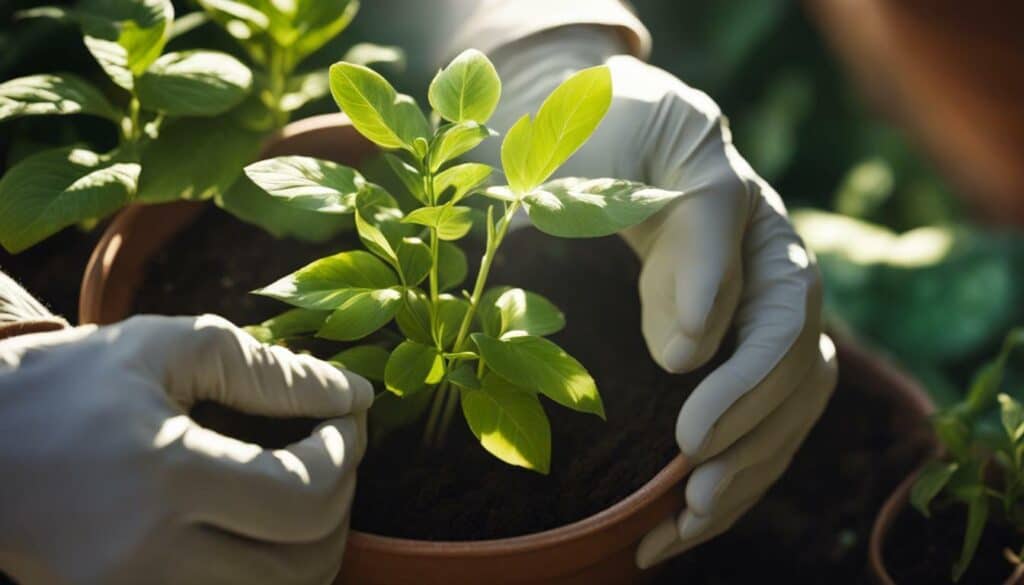
Understanding Soil Science and Composting
To cultivate a thriving garden, it’s essential to understand the fundamentals of soil and harness the power of composting. Let’s explore the fascinating world of soil science and composting techniques.
Soil is the foundation of a healthy garden. Understanding soil types, drainage, and nutrient balance is crucial for promoting plant growth. Clay soil, for example, holds moisture well, but can also become waterlogged and reduce oxygen levels. Sandy soil, on the other hand, drains well but doesn’t retain water or nutrients. Loamy soil is perfect for gardening as it has ideal drainage and water retention properties.
| Soil Types | Properties |
|---|---|
| Clay Soil | Holds moisture well, but can become waterlogged |
| Sandy Soil | Drains well but doesn’t retain water or nutrients |
| Loamy Soil | Ideal drainage and water retention properties |
In addition to soil types, it’s crucial to balance soil nutrients. Adding compost, a rich organic matter made from kitchen scraps and garden waste, is an excellent way to improve soil fertility. Composting is an easy and eco-friendly way to reduce waste while nourishing your garden. A well-maintained compost pile should include a mix of “browns” (such as dried leaves and twigs) and “greens” (like fruit and vegetable scraps), with occasional layers of soil to introduce microorganisms that aid in the decomposition process.
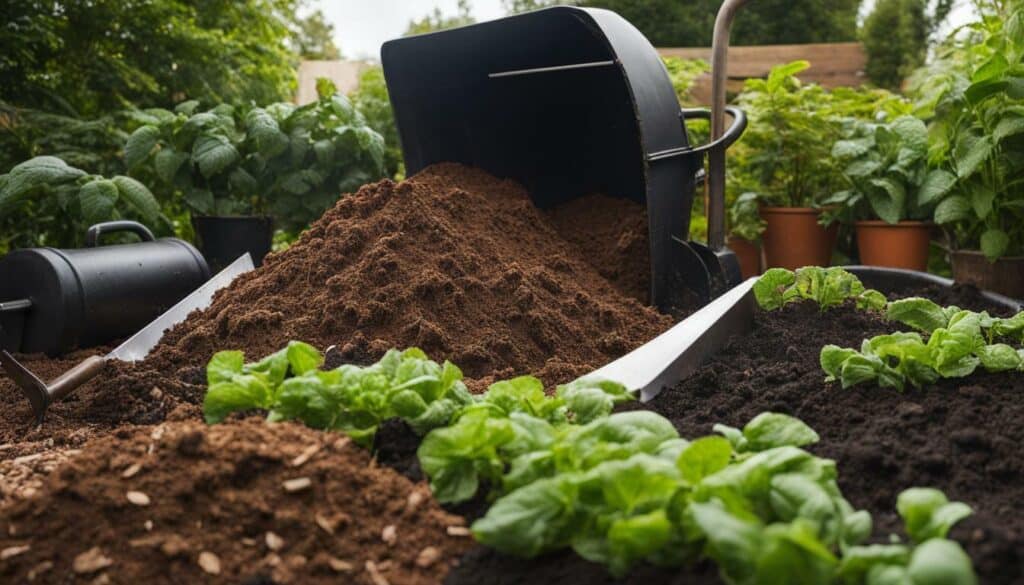
Composting is an easy and eco-friendly way to reduce waste while nourishing your garden.
Composting also helps improve soil structure and water retention. Good soil structure promotes healthy root growth and prevents soil erosion. When compost is added to soil, it enhances the soil’s ability to hold onto water, reducing the need for frequent watering.
Remember that gardening is not only about planting and harvesting. It is also a continuous learning process. Regularly experimenting with new techniques and seeking the guidance of experienced gardeners can help you improve your gardening skills and knowledge.
Essential Tools and Equipment
Just like a painter needs brushes and a musician needs instruments, a gardener relies on a set of essential tools and equipment. In this section, we’ll discover the must-have gardening tools for success.
First and foremost, every gardener needs a spade to dig holes for plants and move soil around. A good quality pair of pruners is also necessary for trimming branches and deadheading flowers. Gloves, both thick and thin, are essential for protecting hands from thorns, cuts, and blisters. Lastly, a watering can is needed for precise watering of plants and flowers.
Investing in high-quality tools is important for a smoother gardening experience. Well-made tools last longer, work better, and ultimately save you money in the long run. Cheap tools may seem appealing, but they break more easily and cost more in the long run.
Garden design is another important factor in successful gardening. Maximizing sunlight exposure and optimizing space is key to a bountiful harvest. Consider what types of plants grow best in your region and choose a layout that suits them.
Watering plants properly is also crucial for plant health. Deep but infrequent watering and mulching can help plants absorb water more effectively and prevent evaporation. Regular maintenance, like trimming and weed control, is also necessary for a thriving garden.
Identifying and addressing pest issues is also important to keep your plants healthy. Using natural methods before resorting to chemicals is advised. Different gardening styles, such as structured or cottage gardens, offer unique aesthetics that can fit anyone’s design preferences.
Indoor gardening is also possible with plants like succulents and herbs. Each season welcomes different plant varieties, so researching optimal planting times is important. Harvesting fruits and vegetables when they are ripe is the gratifying outcome of gardening.
Troubleshooting common issues and joining gardening communities can provide further assistance and support. Taking care of plants requires setting reminders for watering, observing the plants’ health and growth, providing proper light and soil drainage, and recognizing when to water based on the soil’s moisture.
The North Dakota Extension Master Gardener Program offers intensive horticulture training and promotes the health benefits of gardening. They provide research and guidance for planning gardens with perennials and annuals suitable for North Dakota’s climate.
To sum up, having the right tools, designing a garden layout, precise watering, proper maintenance, identifying and addressing pest issues, exploring different gardening styles, and continuous learning are all essential for a successful gardening experience.
Garden Layout and Design
Designing your garden is like creating a masterpiece, where plants become brushstrokes and landscapes transform into works of art. In this section, we’ll explore the key principles of garden layout and design. Whether you have a large garden or a small balcony, proper planning and design can maximize space and sunlight exposure.
Raised beds are recommended for beginners and can be constructed with a variety of materials, such as wood, bricks, or cinderblocks. Soil health is crucial for a thriving garden, and adding organic matter like compost or manure can improve soil structure and provide necessary nutrients for plant growth. Watering deeply but infrequently and using mulch can help retain moisture, and regular maintenance, such as pruning and pest control, is important for the health of your plants.
Gardening offers a variety of styles, such as structured or cottage gardens, allowing you to create a garden that suits your taste. Researching optimal planting times is essential as different seasons call for different plant varieties. Harvesting the fruits of your labor is a rewarding experience, and it is helpful to join gardening communities and get guidance from experienced gardeners.
Indoor gardening is also possible with plants like succulents and herbs. Vegetables can be cultivated indoors with proper light and care. Container gardening is a great option for those with limited outdoor space, and watering frequency depends on plant type and weather conditions. Natural pest control methods, like neem oil, should be explored before resorting to chemicals.
Planning your garden layout according to the seasons of bloom and choosing the right types of plants, whether perennials or annuals, will ensure a beautiful and vibrant garden. The North Dakota Extension Master Gardener Program is a valuable resource for those interested in gardening, offering training, workshops, and research on the health benefits of working with plants.
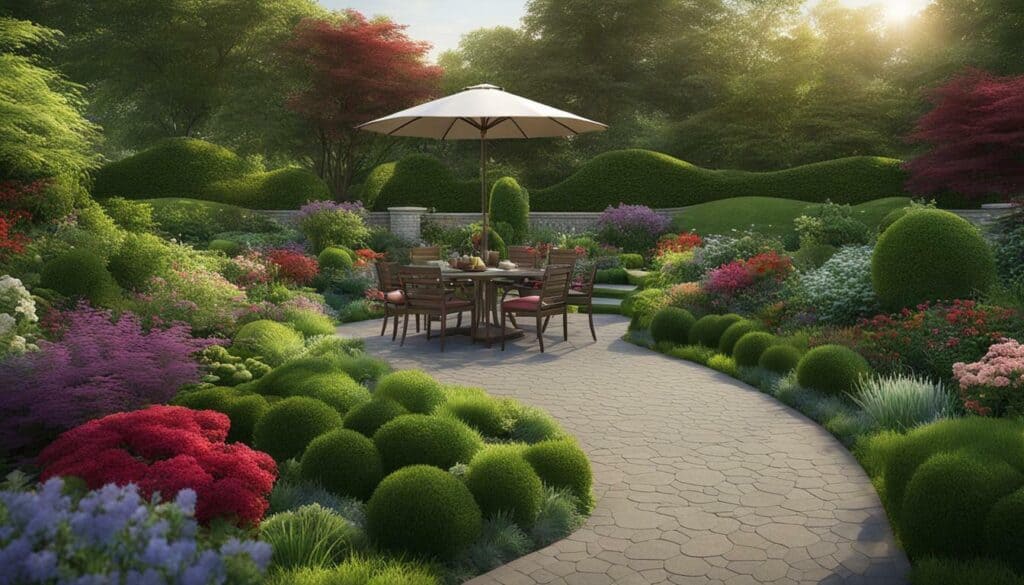
The combination of setting reminders, getting to know your plants, providing adequate light and soil drainage, and maintaining moisture levels can help you keep your plants alive and thriving. With proper planning and design, your garden can transform into a beautiful and peaceful retreat.
Watering Techniques and Frequency
Water is life, and providing your plants with the correct amount of moisture is crucial for their health and vitality. In this section, we’ll explore various watering techniques and frequency guidelines to keep your garden thriving.
According to various sources, watering deeply but infrequently is recommended to encourage deep root growth. This means that you should water your plants thoroughly, allowing the water to penetrate the soil deeply, but less frequently. This technique promotes stronger roots, as the plant must work harder to reach the water source.
Mulching is also important to help retain moisture in the soil and prevent weed growth. A layer of mulch around your plants can help reduce water evaporation and keep the soil cool, making it more hospitable to plant roots.
It is important to pay attention to the needs of individual plants. Check for droopy leaves or new growth as signs that your plant may need watering. Adjust watering frequency accordingly.
Light is also essential for plants. Rotate your plants occasionally to prevent lopsided growth that occurs when one side of the plant receives more light than the other.
Proper soil drainage is critical to keep your plant roots healthy. Make sure your plants have drainage holes at the bottom of their pots, and consider adding a layer of stones at the bottom to encourage water to move through the soil.
The use of moisture as a guide for watering is effective. Water your plants only when the soil is dry and crumbly, ensuring that the water reaches all layers of soil.
Gardening is a beneficial and rewarding activity. If you’re interested in learning more, there are programs and events available to support and educate you. Consider joining a gardening club or attending a gardening workshop to deepen your knowledge and connect with other enthusiasts.
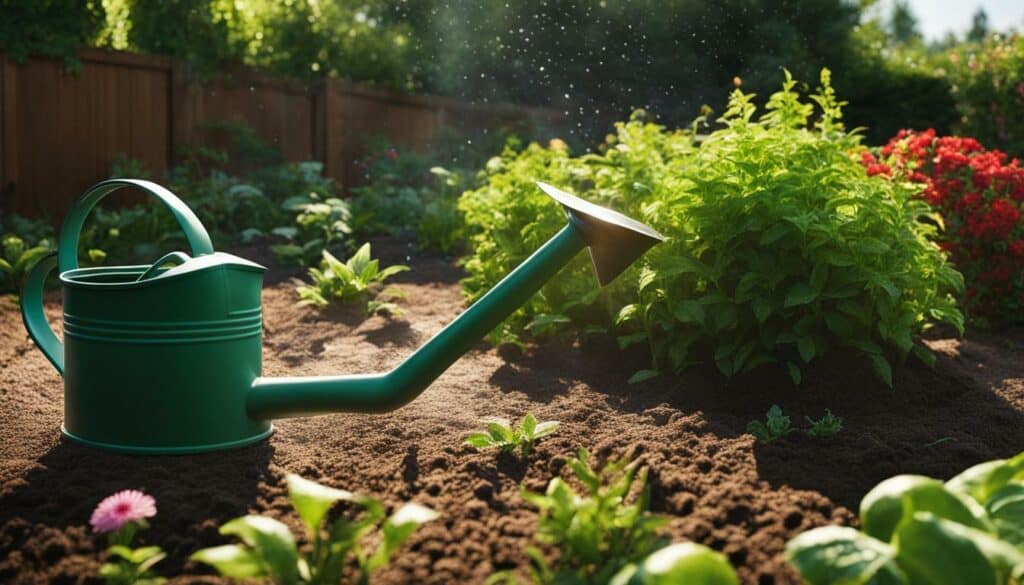
By following these tips and techniques, you can ensure that your garden stays healthy and vibrant throughout the growing season. Remember to always pay attention to your plants’ individual needs and adjust your watering techniques accordingly.
Pruning Tips for Healthier Plants
Pruning is like giving your plants a refreshing haircut – it encourages healthy growth, improves appearance, and ensures your garden remains vibrant and lush. In this section, we’ll uncover the secrets of successful pruning.
Before you start pruning, it is important to select the right plants for your garden. Different plants have different pruning needs, so take into account factors such as sunlight availability, water demands, and the plant’s growth habits. Consider also the plant’s intended purpose – whether ornamental, fruit-bearing, or for vegetable production – and plan accordingly.
Creating healthy soil through composting and understanding drainage and nutrient balance is essential to plant health. Properly equipping yourself with the right tools, including gloves, pruners, and watering cans, is also crucial for successful pruning.
Effective planning, such as designing your garden layout and maximizing sunlight exposure, can lead to healthier plants. Additionally, it is important to water plants deeply and infrequently to encourage deep root growth. Mulching can help retain moisture and control weed growth.
Regular maintenance, including trimming away dead branches, managing pests, and staying vigilant for signs of disease, is key to promoting healthier plants. Remember to always disinfect your pruning tools between plants to avoid spreading disease.
To get more pruning tips and knowledge, join local gardening clubs and online forums to connect with experienced gardeners. They can provide a wealth of knowledge and support, and help you troubleshoot any issues that arise.
By following these pruning tips, you can ensure the health and vitality of your plants. Remember to take your time and be patient, as pruning is a skill that takes time to cultivate. With practice and persistence, you’ll soon master the art of pruning and have a healthy and thriving garden.
Pest Management in the Garden
Dealing with pests can be a frustrating challenge for any gardener, but fear not! In this section, we’ll explore proven methods of pest management to keep your garden pest-free the natural way.
When it comes to pest management, prevention is key. Understanding the needs of your plants, such as sunlight, water, and soil requirements, is essential for their overall health and resilience to pests. Additionally, paying attention to your plants, noticing any changes in leaves and growth patterns, and providing proper care and maintenance can help prevent pest infestations.
Embracing natural pest control methods is recommended before resorting to chemical interventions. One effective solution is introducing beneficial insects, such as ladybugs and praying mantises, which prey on harmful pests like aphids and caterpillars. Additionally, neem oil is a natural pesticide that can be used to control pests like spider mites and whiteflies.
If the problem persists, it may be necessary to seek further guidance. Joining gardening communities and consulting gardening literature can provide valuable support and advice on pest management. It’s important to remember to always read and follow label instructions when using any pest control products.
Remember that a healthy garden is a resilient garden. By understanding the needs of your plants, providing proper care and maintenance, and embracing natural pest control methods, you can keep your garden pest-free and flourishing.

Exploring Various Gardening Styles
Gardening is not a one-size-fits-all endeavor – it embraces a rich tapestry of styles, each with its own allure and charm. In this section, we’ll venture into the world of various gardening styles to find the one that speaks to your soul.
Structured gardens are popular for their clean lines and geometric shapes. They often feature hedges and topiaries, and are well-suited for formal settings. Cottage gardens, on the other hand, are known for their sprawling, dense plantings, mixing vegetables and flowers in a seemingly haphazard way. These gardens have an old-world charm, and are perfect for those who appreciate a more relaxed atmosphere.
Japanese gardens are celebrated for their serene and tranquil atmosphere. They typically feature water elements, such as ponds and streams, and incorporate rocks and stones into their design. Rock gardens are another popular style, featuring arrangements of stones, sand, and gravel to simulate the essence of a natural landscape.
Mediterranean gardens are known for their warm colors, lush foliage, and beautiful mosaics. They often incorporate elements such as terracotta pots, statues, and fountains to create a sense of old-world charm. Likewise, tropical gardens are perfect for those who love the outdoors, with their bold and exotic plantings evocative of the lush rainforests.
Indoor gardening has grown in popularity as people recognize the benefits of bringing the outdoors inside. Plants such as succulents, cacti, and herbs can thrive in indoor conditions with proper care. Container gardening is another option for those with limited outdoor space, allowing you to grow a variety of plants in pots and containers.
Regardless of the style you choose, it’s important to consider the plants’ needs for proper care and maintenance. Ensure they receive the right amount of sunlight and water, and keep them well-fed with nutrients. With the right care and attention, your garden will flourish and bring joy to your life.
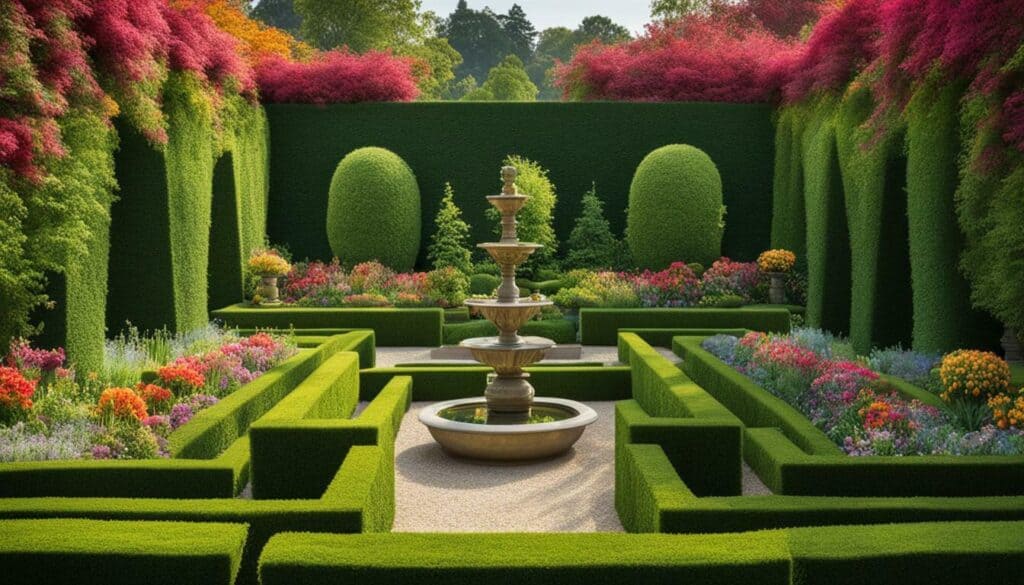
Indoor Gardening and Year-Round Planting
Love gardening but don’t have ample outdoor space? Fear not! In this section, we’ll unlock the secrets of indoor gardening and discover how you can nurture your green thumb year-round.
Indoor gardening is an excellent option for those with limited outdoor space. You can grow a wide variety of plants, such as herbs, leafy greens, and even some fruits and vegetables, indoors with proper care and attention. When starting an indoor garden, it’s important to consider factors such as lighting, temperature, humidity, and air circulation.
One of the most crucial factors in indoor gardening is lighting. Most plants require a minimum of 6-8 hours of sunlight per day, but not all indoor spaces can provide that amount of natural light. In such cases, grow lights can be used to supplement natural light and help plants grow properly.
Another important consideration for indoor gardening is the type of container used. Plants need enough space to grow, and choosing the right size of container is crucial for healthy plant growth. Additionally, it’s recommended to use containers that have drainage holes to prevent waterlogging, which can cause root rot.
When it comes to year-round planting, it’s important to understand that different plants thrive in different seasons. For instance, cool-season vegetables such as lettuce, spinach, and kale do well in the fall and winter, while warm-season vegetables such as tomatoes and peppers prefer the summer months.
To ensure year-round plant growth, it’s important to research optimal planting times for specific vegetables, flowers, and herbs. Additionally, using a planting calendar can help you plan and organize your garden.
Regular maintenance, such as pruning, weed control, and pest management, is crucial for plant health. In indoor gardening, it’s important to keep a consistent watering schedule and avoid overwatering. While not as prevalent as outdoor gardens, indoor plants can still be affected by pests and diseases. Promptly addressing common issues such as yellowing leaves, pests, and diseases can help keep your indoor garden healthy.
Whether you’re a novice gardener or a seasoned pro, joining gardening communities and forums can provide support and learning opportunities in the world of indoor gardening.
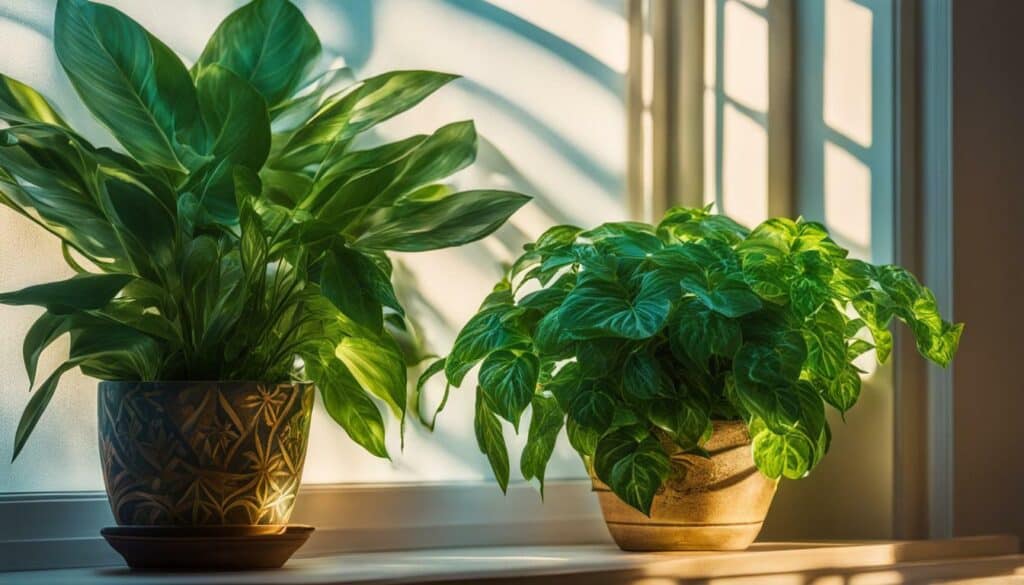
In summary, indoor gardening and year-round planting are perfect solutions for gardeners with limited outdoor space. With the right lighting, containers, and plant selection, you can cultivate a thriving indoor garden. It’s also crucial to understand planting times, watering techniques, and regular maintenance for healthy plant growth. So let’s get planting and enjoy the benefits of having a green thumb year-round!
Resources for Further Gardening Guidance
Your journey studying gardening doesn’t end here – it’s just the beginning! In this section, we’ll explore a plethora of valuable resources that will take your gardening expertise to new heights.
When it comes to online resources, there are plenty of options to choose from. One great place to start is the Old Farmer’s Almanac, which offers a wealth of information on everything from planting and harvesting guides to weather forecasts and recipes using your garden’s bounty. Their website also features a community forum where you can connect with other gardeners to ask questions and share tips.
If you’re looking for more in-depth horticulture training, the Extension Master Gardener Program is an excellent option. Offered by many state agricultural universities, this program provides comprehensive training on topics such as plant pathology, entomology, and soil science. Graduates of the program are then equipped to provide advice and information to their local communities through volunteer work and events.
Another great way to connect with experienced gardeners is through local gardening clubs and organizations. These groups often offer workshops, garden tours, and other events that provide opportunities to learn and network with fellow garden enthusiasts. Check with your local gardening center or community center to find out about groups in your area.
If you’re interested in indoor gardening, the Houseplant Resource Center is an excellent resource. They offer a range of tips and advice for successfully caring for houseplants, including setting watering reminders, identifying common pests and diseases, and selecting the right soil and containers for your plants.
Finally, for those in North Dakota, the North Dakota Extension Master Gardener Program is an excellent resource for gardening tips and advice. They offer a wide range of information on selecting plants that are suitable for the region, as well as detailed information on soil health and other topics. They also offer an extensive list of research and beautification projects that can provide inspiration for your own garden.
With so many resources available, there’s no excuse not to become an expert gardener. Whether you’re a beginner or an experienced gardener, there’s always more to learn and discover. So get out there and start exploring!
Container Gardening for Limited Spaces
Don’t let limited outdoor space deter you from experiencing the joys of gardening! In this section, we’ll explore the wonders of container gardening and discover how you can transform small spaces into lush green paradises.
Container gardening is a great option for those who live in apartments or have limited outdoor space, such as on a balcony or patio. It allows individuals to reconnect with nature and enjoy the benefits of gardening even in urban environments.
When starting a container garden, it’s important to select plants that are suitable for your climate and space. Some great options for container gardening include tomatoes, basil, and marigolds. Understanding soil science and composting is essential for maintaining healthy soil and ensuring the success of your plants.
Equipping yourself with the right tools is important for a smooth gardening experience. Some essential tools for container gardening include spades, pruners, gloves, and a watering can.
Proper planning and layout design can help maximize sunlight exposure and optimize the use of space. Watering your plants deeply but infrequently, mulching to retain moisture, and regularly maintaining your garden are also necessary for its flourishing.
Identifying and addressing pest issues promptly is important, and using eco-friendly solutions like neem oil or introducing beneficial insects can help.
Container gardening can also be done indoors with the right plants and care. Different seasons require different plant varieties, so researching optimal planting times is crucial. Harvesting the fruits and vegetables of your labor is a rewarding part of gardening.
Yellowing leaves, pests, and diseases are common challenges that can be addressed with proper education and care. Joining local gardening clubs and online forums can provide opportunities to connect with like-minded individuals and learn from experienced enthusiasts.
Overall, container gardening is a fulfilling and adaptable way to enjoy plants and nature, regardless of limited outdoor space.
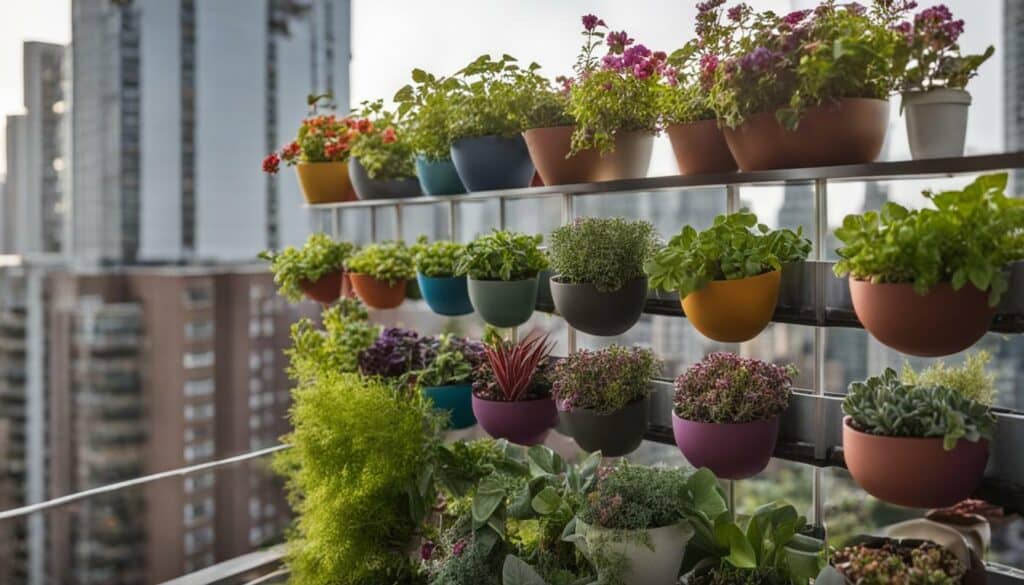
Conclusion:
Congratulations, you’ve reached the end of “Master the Green Thumb: Your Guide to Studying Gardening!” Armed with valuable knowledge and practical tips, you’re now ready to embark on a lifelong journey of nurturing beautiful gardens and cultivating your green thumb. Remember, gardening is a rewarding and fulfilling activity that provides therapeutic benefits and enhances our connection to nature.
Whether you have a large garden or limited outdoor space, there are options available, such as container gardening, that can accommodate your needs. Embarking on a gardening journey requires some basic knowledge and skills, but with perseverance and attention to your plants’ needs, you can successfully keep them alive. Setting reminders for watering and getting to know your plants will help you maintain their health and vitality. Additionally, factors like light, soil drainage, and moisture control are crucial for plant growth.
Participating in the Master Gardener program can provide you with in-depth horticulture training and opportunities to contribute to your community. The program also focuses on the therapeutic benefits of working with plants and encourages everyone to incorporate more greenery into their lives.
With proper planning and understanding of the different types of plants, you can create a vibrant garden that blooms throughout the seasons. So, start your gardening journey today and experience the joy of watching your plants thrive and flourish.
Is the Gardening for Beginners Book Suitable for Someone New to Gardening?
Is the gardening for beginners book suitable for someone new to gardening? Absolutely! This comprehensive guide covers all the basics, making it perfect for those starting their gardening journey. Packed with helpful tips, step-by-step instructions, and insightful advice, the gardening for beginners book ensures that even novices can create and maintain a flourishing garden.
FAQ
Q: How do I select the right plants as a beginner?
A: When selecting plants for beginners, it’s important to choose varieties that are low-maintenance and suited to your specific growing conditions. Look for plants that are labeled as “easy to grow” or “beginner-friendly” and consider factors such as sunlight requirements, soil type, and water needs.
Q: What should I know about soil science and composting?
A: Understanding soil science is crucial for successful gardening. Learn about soil composition, pH levels, and nutrient content, and make amendments as needed. Composting is a sustainable way to enrich your soil with organic matter and nutrients. Collect kitchen scraps, yard waste, and other organic materials, and create a compost pile or use a compost bin to create nutrient-rich compost for your plants.
Q: What are the essential tools and equipment for gardening?
A: Gardening requires a few essential tools and equipment, such as a trowel, pruners, garden gloves, a watering can or hose, and a garden rake. These tools will help you with planting, pruning, watering, and maintaining your garden. It’s important to choose high-quality tools and properly maintain them for long-lasting use.
Q: How can I design an attractive garden layout?
A: When designing your garden layout, consider factors such as the available space, sunlight exposure, and plant requirements. Plan your garden beds and pathways, incorporate focal points or garden structures, and choose a color scheme or theme that complements your outdoor space. Experiment with different designs and layouts to find what works best for you.
Q: What are the proper watering techniques and frequency for plants?
A: Proper watering techniques vary depending on the type of plants and their specific water needs. Generally, it’s best to water deeply and infrequently, allowing the soil to dry out slightly between waterings. Monitor the moisture levels of your plants by checking the soil with your finger or using a moisture meter. Adjust your watering schedule as needed to ensure your plants receive the right amount of water.
Q: How can I prune my plants for healthier growth?
A: Proper pruning helps promote healthier plant growth and improves the overall appearance of your garden. Remove any dead, damaged, or diseased branches, and trim back overgrown or unruly growth. Follow appropriate pruning techniques for different types of plants, and avoid over-pruning or pruning at the wrong time of year.
Q: How can I manage pests in my garden?
A: Pest management in the garden can be achieved through various methods. Try using natural pest control methods such as companion planting, beneficial insects, and homemade organic sprays. Regularly inspect your plants for signs of pests, and take action to prevent infestations. If necessary, use organic insecticides or consult a professional for assistance.
Q: What are some popular gardening styles to explore?
A: There are various gardening styles to explore, including formal gardens, cottage gardens, Japanese gardens, and Mediterranean gardens, among others. Each style has its own unique characteristics and design elements. Research different styles to find one that aligns with your personal taste and complements your outdoor space.
Q: How can I continue gardening indoors and throughout the year?
A: Indoor gardening allows you to continue gardening even with limited outdoor space or during the colder months. Choose plants that thrive indoors, provide adequate lighting, and create a suitable growing environment. Consider using grow lights and maintaining proper temperature and humidity levels. Additionally, plan your outdoor garden to include plants that bloom at different times of the year for year-round beauty.
Q: Where can I find additional gardening guidance?
A: There are numerous resources available for further gardening guidance. Explore online platforms dedicated to gardening, such as gardening forums, social media groups, and informative websites. Gardening literature, including books and magazines, can provide valuable insights and inspiration. Blogs written by experienced gardeners can also offer practical tips and personal experiences to enhance your gardening journey.
Q: How can I garden in limited outdoor space?
A: Container gardening is a suitable option for gardening in limited outdoor space. Choose appropriate containers and potting mix, and select plants that are well-suited for container gardening. Consider vertical gardening techniques, hanging baskets, or window boxes to make the most of your available space. Be mindful of watering needs and provide proper drainage for your containers.
Source Links
- https://medium.com/@mohammed.touson/gardening-for-beginners-a-comprehensive-guide-to-cultivating-your-green-thumb-8bfd4f73e3a9
- https://trendsettersfargo.com/green-thumb-master-gardener/amp/
- https://realitydaydream.com/a-beginners-guide-to-a-green-thumb-keeping-plants-alive/
- https://now.tufts.edu/2021/04/23/growing-green-thumb
- https://www.finegardening.com/article/community-gardening-sharing-your-green-thumb-passion
- https://www.amazon.com/Mister-Owitas-Guide-Gardening-Unexpected/dp/0425273830
- https://www.cnps.org/gardening/choosing-your-plants
- https://www.realhomes.com/advice/how-to-choose-plants-for-your-garden
- https://www.fromhousetohome.com/garden/pick-the-right-plants/
- https://www.sustainablemarketfarming.com/2023/06/21/book-review-compost-science-for-gardeners-by-robert-pavlis/
- https://www.finegardening.com/project-guides/gardening-basics/the-basics-of-soil-biology
- https://www.amazon.com/Soil-Science-Gardeners-Working-Nature/dp/0865719306
- https://www.gardendesign.com/how-to/tools.html
- https://www.almanac.com/gardening-tools-guide
- https://www.melaniejadedesign.com/15-must-have-gardening-tools/
- https://courses.finegardening.com/garden-design-ideas
- https://www.countryliving.com/gardening/garden-ideas/g746/garden-plans/
- https://www.uclaextension.edu/landscape-architecture-horticulture/courses
- https://extension.umn.edu/how/watering-vegetable-garden
- https://www.gardeners.com/how-to/when-to-water/8108.html
- https://www.cleanairgardening.com/garden-watering-frequency-best-practices/
- https://risegardens.com/blogs/communitygarden/pruning-good-for-your-plants-and-garden
- https://thistledownsfarm.com/6-simple-pruning-tips-for-beginners/
- https://www.bhg.com/gardening/trees-shrubs-vines/care/what-to-prune-when/
- https://www.usda.gov/peoples-garden/gardening-advice/ipm
- https://www.canr.msu.edu/news/ipm_smart_pest_management_for_the_vegetable_garden
- https://gardenerspath.com/how-to/disease-and-pests/integrated-pest-management/
- https://njaes.rutgers.edu/fs1211/
- https://www.theimpatientgardener.com/discovering-garden-styles-modern-gardens/
- https://www.amazon.com/Exploring-Garden-Style-Gardeners-Gardening/dp/1561584746
- https://www.thespruce.com/indoor-gardening-beginner-guide-5199347
- https://www.tenthacrefarm.com/year-round-gardening/
- https://www.amazon.com/Garden-Indoors-Grow-Your-Round/dp/1580115748
- https://www.usda.gov/peoples-garden/gardening-advice
- https://extension.psu.edu/trees-lawns-and-landscaping/home-gardening
- https://www.artfulhomemaking.com/gardening-for-beginners/
- https://sowsmallgarden.com/container-garden/
- https://www.almanac.com/content/container-gardening-vegetables
- https://charlottemasonmotherhood.com/2020/04/how-to-start-a-small-container-garden.html
- https://www.daleharvey.com/in-the-garden/articles-of-interest/PACIFIC STEEL SUTTON PARK/Sutton Park Primary School Gardening Project/Page 5 – Conclusion.html
- https://www.ncbi.nlm.nih.gov/pmc/articles/PMC6334070/
- https://www.ncbi.nlm.nih.gov/books/NBK373975/

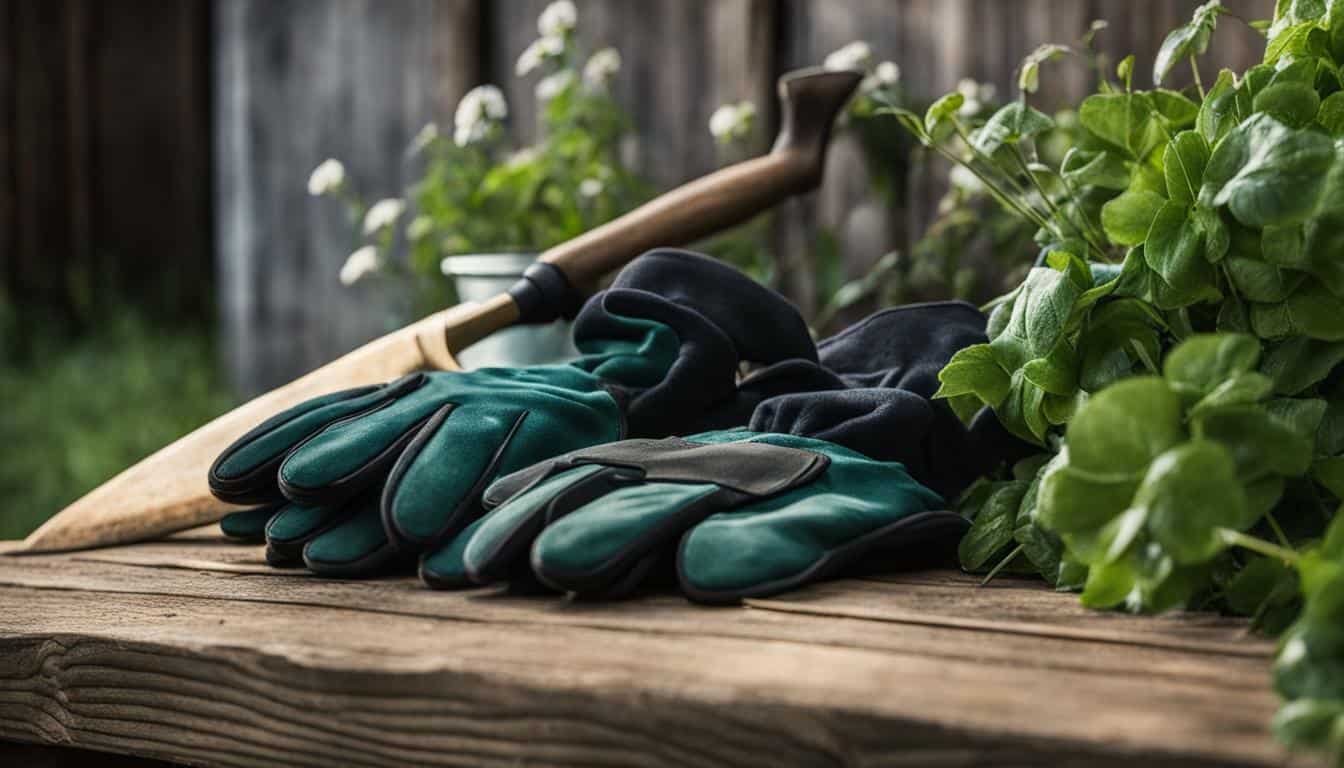



Leave a Reply